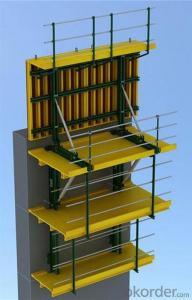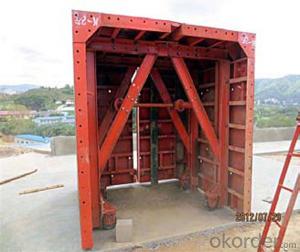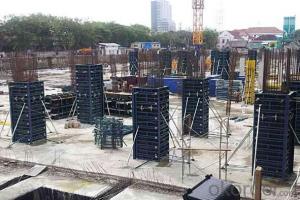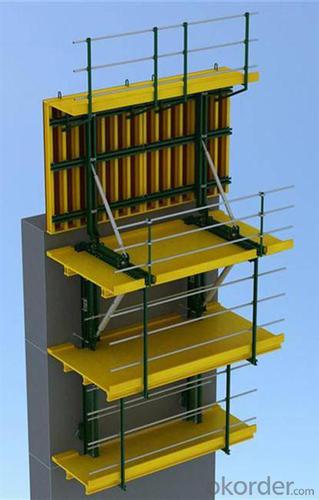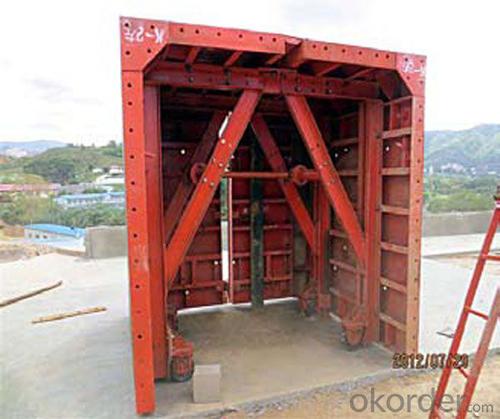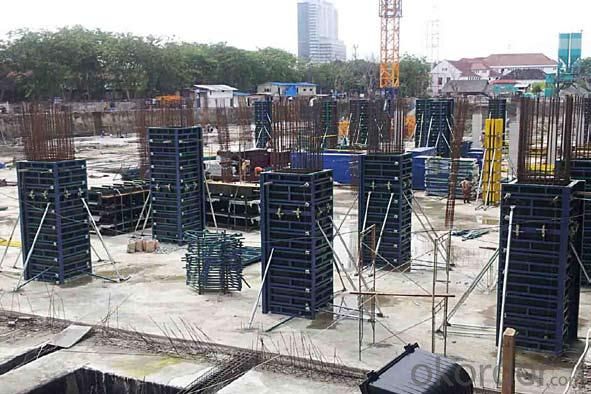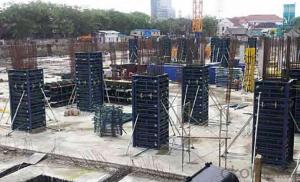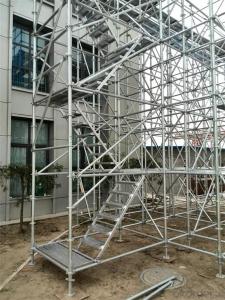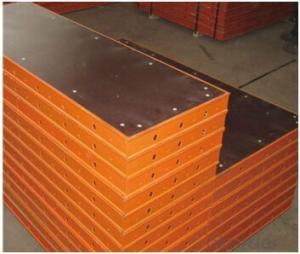Plastic Scaffold System Formwork System Formwork low price
- Loading Port:
- Tianjin
- Payment Terms:
- TT OR LC
- Min Order Qty:
- 30 m.t
- Supply Capability:
- 1000 m.t/month
OKorder Service Pledge
OKorder Financial Service
You Might Also Like
Plastic Scaffold System Formwork System Formwork low price
Product pictures:
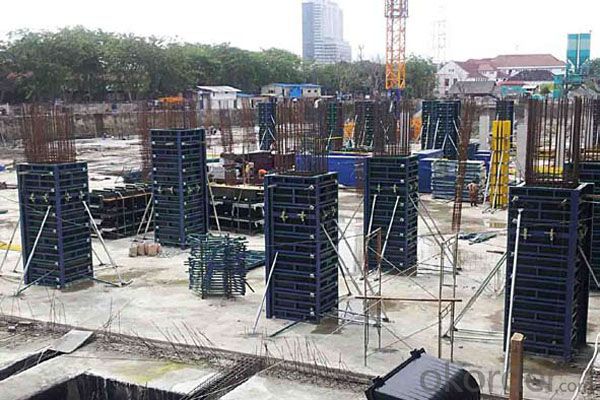
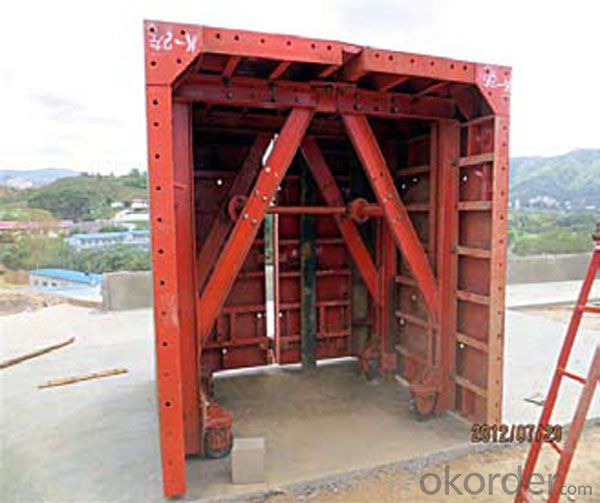
Product description:
Name: | RingLock Scaffold System |
Category: | Scaffolding System |
Material: | Steel (Q235/Q345) |
Size: | D48*3.25mm, etc |
Surface: | Electro Galvanized, Hot Dipped Galvanized, Painted, Powder Coated |
Component: | Standard, Ledger, Diagonal Brace, Bracket, Base Jack, U Head Jack, Etc. |
Application: | Slab Support, Staircase, Stage Plateforms, Bridge Support, Mobile Tower, etc. |
Manufacturer: | OEM is Available |
Items or goods can be manufactured according to your standards. | |
Advantage
* Good loading capacity
* Easy to assemble and dismantle
* Excellent quality for formwork & scaffolding with wide choices
Other scaffolding & formwork products:
(1) Scaffolding System:
(2) Scaffolding Frame & Accessories:
(3) Scaffolding Couplers/Clamps:
(4) Formwork System Scaffolding & Accessories:
Company introduce and advantages:
1. One of Fortune 500 companies in the world. No. 5 in the building material fi eld.
2. Six Sigma strategy , which means no more than 3.4 defects existing among one million of error
possibilities.
3. In line with the business, we launched E-business platform Okorder.com.
4. We are highly recognized by our business partners and clients all over the world and has obtained rapid
development under the spirit of win-win.
FAQ
Why Us?
We are one of the largest construction materials suppliers in China.
We own professional manufacturers with powerful producing capacity.
Extensive and comprehensive quality control system
Excellent products with competitive prices.
Efficient services in pre and after sale.
Full energy with affluent experience team.
- Q: Are there any disadvantages to using steel frame formwork?
- There are indeed a few drawbacks to utilizing steel frame formwork. To begin with, in comparison to alternative formwork types like timber or aluminum, steel frame formwork tends to be more expensive. This can dissuade smaller construction projects or those with limited budgets. Furthermore, due to its relatively heavy nature, steel frame formwork necessitates machinery or additional manpower for handling and installation. This can result in increased overall construction time and costs. In addition, steel frame formwork lacks the flexibility of other formwork types. It is typically prefabricated to meet specific project requirements, making it less easily adjustable or adaptable to changes in design or dimensions. Lastly, regular maintenance and proper storage are necessary to prevent rust and corrosion of steel frame formwork. If not properly maintained, the formwork may deteriorate over time, posing safety risks and requiring expensive repairs or replacement. Despite these drawbacks, steel frame formwork offers numerous advantages such as high strength, durability, and reusability. As a result, it is commonly employed in large-scale construction projects where the benefits outweigh the drawbacks.
- Q: What is the maintenance required for steel frame formwork?
- The maintenance required for steel frame formwork involves regular cleaning, inspection for any signs of damage or wear, and appropriate storage to prevent rusting or corrosion. Additionally, any necessary repairs or replacements should be carried out promptly to ensure the formwork remains in good working condition.
- Q: What are the common design standards and codes applicable to steel frame formwork?
- Some common design standards and codes applicable to steel frame formwork include the American Concrete Institute (ACI) 347-04, the European Standard EN 12812:2008, and the British Standard BS 5975:2008. These standards provide guidelines for the design, construction, and use of steel frame formwork systems, ensuring safety, efficiency, and quality in concrete construction projects.
- Q: How does steel frame formwork handle the placement of embedded items, such as electrical conduits or plumbing pipes, within the concrete structure?
- A versatile system, steel frame formwork handles the placement of embedded items in concrete structures effectively. The steel frames offer sturdiness and rigidity, allowing for precise positioning and support of electrical conduits or plumbing pipes during the pouring process. One of the main advantages of steel frame formwork lies in its adaptability. The frames can easily be adjusted or modified to accommodate different sizes and types of embedded items. This flexibility guarantees proper positioning and secure fixation of conduits or pipes, minimizing the risk of displacement or damage during construction. Furthermore, the steel frames provide a stable and reliable support system for the embedded items. They are designed to withstand the weight of the concrete and other construction loads, ensuring that the conduits or pipes remain in their intended position without sagging or movement. This is essential for maintaining the integrity and functionality of the electrical or plumbing systems within the structure. Moreover, steel frame formwork enables efficient installation of embedded items. The frames can be easily assembled and disassembled, allowing for quick and accurate placement of conduits or pipes before concrete pouring. This not only saves time and labor costs, but also reduces the risk of errors or rework. Additionally, steel frame formwork ensures a smooth and consistent surface finish for the concrete structure. This guarantees proper encasement and protection of the embedded items, preventing potential damage or corrosion. It also facilitates the subsequent installation of finishes or coatings, as the surface is even and free from any obstructions caused by the embedded items. Overall, steel frame formwork is a reliable and efficient system for handling the placement of embedded items in concrete structures. Its adaptability, stability, and ease of installation make it an ideal choice for ensuring the proper positioning and support of electrical conduits or plumbing pipes, resulting in a structurally sound and functional final product.
- Q: How to define the structural system of the upper part of the bottom steel frame
- (PS: regarding the specification and selection of structure types, characteristics and structure as well as the earthquake was not simply that, according to the above statement set must be correct, need further discussion.)Framework modeling: frame "to 3D model and load model, input directory is still just entered, can see the program automatically generates each standard layer on top of the roof also automatically set the" node on high". This is why I suggest to use the portal frame modeling, which can skew and variable cross-section beam generating top-level conveniently.
- Q: How does steel frame formwork accommodate for different concrete placement methods?
- Steel frame formwork is a versatile and adaptable system that can accommodate various concrete placement methods. The primary advantage of steel frame formwork is its ability to be easily adjusted and modified to suit the specific requirements of different concrete placement techniques. One way in which steel frame formwork accommodates different concrete placement methods is through its adjustable panel sizes. The size and configuration of the formwork panels can be altered to match the desired shape and dimensions of the concrete structure. This flexibility allows for efficient and accurate placement of concrete, regardless of whether it requires traditional pouring, pumping, or pouring in layers. In addition, steel frame formwork can incorporate various accessories and additional components to support different concrete placement methods. These accessories may include adjustable braces, tie rods, and connectors, among others. These components enable the formwork to withstand the pressure and weight of the concrete during the pouring process, ensuring the stability and integrity of the structure. Another way in which steel frame formwork accommodates different concrete placement methods is by providing easy access for reinforcement installation. The formwork system can be designed to allow for the placement of reinforcing bars, mesh, or other reinforcement materials as required by the specific concrete placement technique. This ensures the structural strength and durability of the concrete once it has cured. Furthermore, steel frame formwork can be easily dismantled and reassembled, making it suitable for repetitive use in projects with multiple concrete placements. This feature allows for efficient and cost-effective construction, as the formwork can be quickly adjusted and reused for subsequent pours. In summary, steel frame formwork offers a range of features and capabilities that accommodate different concrete placement methods. Its adjustable panel sizes, incorporation of accessories, provision for reinforcement installation, and ease of dismantling and reassembly all contribute to its adaptability and versatility in accommodating various concrete placement techniques.
- Q: How does steel frame formwork handle the removal of formwork after concrete curing?
- Steel frame formwork is a popular choice in the construction industry due to its durability and strength. When it comes to the removal of formwork after concrete curing, steel frame formwork offers several advantages. Firstly, steel frame formwork is designed to be easily disassembled and removed. The formwork system consists of steel frames that are connected together using various fastening mechanisms, such as clamps or bolts. This allows for a quick and efficient dismantling process, minimizing downtime and labor costs. Additionally, steel frame formwork offers excellent load-bearing capacity. This means that it can support the weight of the concrete during the curing process, eliminating the need for additional supports. As a result, the removal of formwork is relatively straightforward, as the steel frames can be safely lifted and detached, without compromising the integrity of the concrete structure. Moreover, steel frame formwork is reusable, which makes it a cost-effective option. Once the formwork is removed, it can be cleaned, inspected, and prepared for future projects. This not only reduces material waste but also saves money on purchasing new formwork for each construction project. Furthermore, steel frame formwork provides a smooth and even finish to the concrete surface. The steel frames are designed to be rigid and stable, ensuring that the concrete retains its shape and structure during the curing process. This results in a high-quality finish, reducing the need for additional surface treatments or repairs after formwork removal. Overall, steel frame formwork is a reliable and efficient solution for handling the removal of formwork after concrete curing. Its ease of disassembly, load-bearing capacity, reusability, and ability to produce a smooth finish make it a preferred choice for construction projects.
- Q: What are the different types of formwork accessories used with steel frame formwork?
- There are several different types of formwork accessories that are commonly used with steel frame formwork. These accessories are designed to enhance the efficiency and effectiveness of the formwork system, allowing for easier installation and removal of the formwork. One common type of formwork accessory used with steel frame formwork is the formwork clamp. These clamps are used to securely hold the formwork panels together, ensuring that they remain in place during the pouring and curing of the concrete. Formwork clamps are typically made from steel or other durable materials and come in a variety of sizes and designs to accommodate different formwork configurations. Another type of formwork accessory used with steel frame formwork is the formwork tie. These ties are used to connect the formwork panels to the frame, providing additional stability and strength to the system. Formwork ties are typically made from steel or plastic and are available in various lengths and sizes to accommodate different formwork heights and thicknesses. Formwork brackets are another commonly used accessory with steel frame formwork. These brackets are used to support the formwork panels at specific angles or positions, allowing for the creation of complex shapes and structures. Formwork brackets are typically adjustable and can be easily attached to the frame, providing flexibility in formwork design. Additionally, formwork spacers are used to maintain a consistent spacing between formwork panels, ensuring that the concrete is poured evenly and uniformly. These spacers are typically made from plastic or metal and come in various sizes to accommodate different formwork thicknesses. Finally, formwork release agents are often used as accessories to facilitate the easy removal of the formwork once the concrete has cured. These release agents are applied to the surface of the formwork panels before pouring the concrete, creating a barrier that prevents the concrete from sticking to the formwork. This allows for easy and efficient removal of the formwork, reducing the time and effort required for dismantling. Overall, these various types of formwork accessories are essential in enhancing the performance and functionality of steel frame formwork systems. They contribute to the efficient installation and removal of the formwork, ensuring a smooth and successful concrete pouring process.
- Q: What are the different types of formwork chamfer solutions available for steel frame formwork systems?
- Some of the different types of formwork chamfer solutions available for steel frame formwork systems include chamfer strips, chamfer profiles, and chamfer blocks. These solutions are used to create beveled or angled edges on the concrete formwork, resulting in smooth and precise corners. Chamfer strips are typically made of plastic or rubber and can be easily attached to the formwork to create the desired chamfered edge. Chamfer profiles are pre-formed strips or profiles that are fixed onto the formwork to achieve consistent chamfer dimensions. Chamfer blocks are reusable blocks that are placed at the corners of the formwork to create chamfered edges. Overall, these chamfer solutions offer flexibility and efficiency in achieving high-quality finishes for steel frame formwork systems.
Send your message to us
Plastic Scaffold System Formwork System Formwork low price
- Loading Port:
- Tianjin
- Payment Terms:
- TT OR LC
- Min Order Qty:
- 30 m.t
- Supply Capability:
- 1000 m.t/month
OKorder Service Pledge
OKorder Financial Service
Similar products
Hot products
Hot Searches
Related keywords
